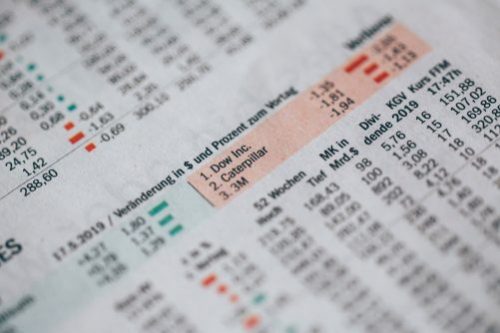
The reason for this post is to tell you/remind you about Rakuten – by far the easiest way to potentially save A LOT of money on your Christmas shopping (or any other time as well). It’s called Rakuten (formerly Ebates), and I have been getting checks from them for about 10 years now. In fact, […]
The post Rakuten just paid me $775.60 appeared first on .

Teach kids entrepreneurial and business skills with these simple sweets kids can make and sell for Market Days, fundraisers, bake sales, etc.
Looking for some unique and simple food Market Day ideas for kids to sell (sweets)?
I’ve got some fresh ones for you below.
Just follow the simple steps, and your child will soon be creating their first business product, plus learning how to sell something!
They’re about to learn some fantastic skills (not to mention, raise some cash).
Market Day Ideas for Kids to Sell – Sweets
1. Rice Krispies Treats™ Pops
What an awesome, and simple, upgrade to the typical Rice Krispies Treats™!
Ingredients:
- Chocolate to melt (like semi-sweet chocolate chips)
- Coconut Oil
- Rice Krispies Treats (homemade, or store-bought)
- Sprinkles to dip in
- Food-grade treat sticks/popsicle sticks
Instructions:
Melt the chocolate in the microwave, using a mini slow cooker, etc. Add in about 1 tbsp of coconut oil per cup of chocolate.
Stick the treat sticks through each Rice Krispies Treat™.
Dip the Rice Krispies Treat into the chocolate. Tap it against the side of the bowl to remove excess chocolate. Doesn’t have to cover the whole thing, or be perfect!
Dip it into sprinkles.
Set it on a cooling rack to harden up.
Package up.
2. Foot-Long Cookie Bars
Have you seen the new foot-long cookie bars at Subway®?
I thought they’d be perfect to sell at an event – especially because someone walking around eating a foot-long cookie is a great advertisement, too.
This one is quite simple. Find a cookie bar recipe (I used this one but with chocolate chips), and make sure it fits into a 9” X 13” pan (which happens to measure 1 ft lengthwise).
Allow everything to cool, and cut it into 1-ft. long strips.
Then package it up. I was able to fit them into a lunch bag, or in some parchment paper (you could staple the end if you want to).
3. Playing Card Cookies with Dice
Sometimes, packaging a product with a little somethin’ extra makes all the difference.
That was my thinking with this idea: to bake card-shaped cookies, and include colorful dice with each purchase.
You can find the playing card suit cookie cutters here, and the colorful dice here.
You’ll want to find a sugar cookie recipe (I used a package from the Dollar Tree, just to show you my idea), and icing that will harden.
Bake the cookies in the playing card suit shapes, add icing to them, and allow them to harden/dry, then package them up with as many dice as you’d like (I put the dice in really small baggies so that they wouldn’t touch the food inside).
4. Cookie Dough Cutters
Did you know there is a safe way to eat raw cookie dough?
In fact, people have made entire businesses from it!
What makes it “safe” is you heat-treat the flour, and you use pasteurized egg whites in the recipe.
I read Kristen Tomlan’s book Hello, Cookie Dough, and got to thinking…why not create safe raw cookie dough and package it up in a cute way to sell for market day, bake sales, fundraisers, and more?
Here are the materials:
- Cookie cutters (you might want to get plastic ones, so there’s no potential for rust)
- Little spoons (I got these silver ones at Dollar Tree)
- Plastic bag
- Ribbon
- Ingredients for raw cookie dough
- Parchment paper
After you make the cookie dough, cut square pieces of parchment paper and put one behind each cutter. Fill the cutter with cookie dough (as high as you’d like). Package it with a mini-spoon tied around the plastic with ribbon.
People get to eat the raw cookie dough, and then keep a cute cookie cutter to use later!
Hint: you can get that book for recipes, or look online for safe raw cookie recipes like this one. Also, don’t forget to clean the cookie cutters before using them with food for the first time, and to find a way to keep them cool during the event.
5. Edible Chocolate Gemstones
Look at these beautiful chocolate gems?!
Ingredients:
- Meltable chocolate (like semi-sweet chocolate chips)
- Edible Glitter
- Gem silicone molds
Instructions:
- Melt the chocolate.
- Place in the molds.
- Let cool. Then take the gems out.
- Dip the gems into the edible glitter.
- Package up.
6. Edible Gemstones
It’s kind of hard to coat almonds in a candy melt/coconut oil mixture and get them to look smooth (at least for an amateur baker, like myself).
But I figured out that when you coat those “unsmooth” almonds in edible glitter?
Well, they look like gem rocks!
Ingredients:
- Whole Almonds
- White candy melts (or whatever color you’d like)
- Coconut oil
- Edible Glitter
Instructions:
- Melt together a bunch of candy melts and coconut oil (about 1-1.5 tbsps. of coconut oil to one cup of candy melts).
- Drop almonds into the melted mix, and stir to cover thoroughly.
- Use a slatted spatula or spoon to fish the almonds out. Lay them on parchment paper to cool.
- Put 1.5 tbsps. or so of edible glitter into a small plastic bag, and add in 5-7 coated almonds. Shake up, then take them out and put them on a plate. Repeat for all of the coated almonds.
7. Rainbow Chocolate Bars
This one is so simple, and it packs a punch!
Ingredients:
- Chocolate Bars
- Colorful Candy Melts
Grab chocolate bars that are already made – definitely price check and try to buy in bulk for this one.
For example, you can buy this pack of 36 full-sized chocolate bars for about $0.65 each.
You’ll need candy melts of different colors, cellophane food bags, and a ribbon to tie them off. I also grabbed some gorgeous glass beads that I thought would interest buyers more because they get to keep the bead after they eat the chocolate!
Simply follow the instructions on how to melt the candy melts, then unwrap and decorate your chocolate candy bars. Splashes of color, coloring the whole bar with one color as I did, or trying out graffiti would be fun, too!
Let them dry and wrap them in the cellophane bag. Thread a glass bead through the ribbon (if you’re using one), and tie it around the bag.
That’s it! Which Market Day food sweets are you most excited to make and sell?

Is The Kohl Stock The Next Big Short Squeeze Opportunity?
Is Kohl’s The Next Big Short Squeeze Opportunity?
The mass retail sector is facing what many consider a terminal decline.
Disrupted by the rise of e-commerce and the ongoing “retail apocalypse”, traditional brick-and-mortar retailers like Kohl’s have struggled to compete.
Baby boomers, once a key consumer group, are aging and shopping less, while younger generations—Millennials and Gen Z—are more inclined to favor the convenience of online shopping over in-store experiences.
Often Kohl is named “your mother’s favorite retailer”, not the greatest label in the fast-changing times we live in!
The Kohl’s Stock
Despite these headwinds, Kohl’s stock price has fallen to what I believe is an irrational level.
Let’s take a look at the chart, which saw a height of $82 in 2018:
new TradingView.widget({
'width': 800,
'height': 600,
'symbol': 'KSS',
'interval': 'W',
'timezone': 'Europe/Berlin',
'theme': 'White',
'style': '8',
'locale': 'en',
'toolbar_bg': '#015187',
'enable_publishing': false,
'withdateranges': true,
'hide_side_toolbar': true,
'allow_symbol_change': false,
'save_image': true,
'hideideas': true,
'hideideasbutton': true,
'referral_id': 'Rudi_Hess'
});
Down by 77%!
A New Short Squeeze Opportunity In The Making?
More than a third of its float (!!) is currently sold short, as you can see on the excellent dashboard on Finviz (see blue arrow).
Simply put, short sellers are betting that the stock price will drop further. To do this, they borrow shares, paying significant interest to maintain the short position as they wait for the price to decline.
Whoever is interested in short squeezes should watch the excellent movie ‘Dumb Money‘ by Craig Gillespie.
What might happen here is a classical short squeeze. This happens when coordinated buying (e.g. by Reddit-led retail investors) drives up the stock price to a certain level, forcing short sellers to cover their positions (aka buying the stock on the open market), thereby amplifying the rally further.
Kohl’s Hidden Assets
The company’s true value might be overlooked, especially when factoring in its owned property portfolio.
The real estate alone is worth at least twice Kohl’s entire enterprise value (including its financial debt). In relation to its market capitalization, the value approaches nearly 4x, based on conservative, depreciated property valuations.
This suggests that the market may be significantly underestimating Kohl’s long-term potential, positioning it as a compelling candidate for a Reddit-fueled short squeeze, similar to what we saw with retail peer GameStop (GME) or cinema chain AMC (AMC).
Both of these stocks saw massive gains, with AMC, for example, surging from $15 to $350 in just a few months, an increase of 20-25x!
Given that Kohl’s is also part of the traditional, old-school retail sector, it aligns well with the type of targets that often attract the Reddit army’s hunger for the next big short-squeeze opportunity.
Compare Kohl’s current market cap with its total assets – we can note an almost 7x difference.
We get a similar image when looking at Kohl’s price-to-book and price-to-sales ratios.
Both are at a historical low. Never in history could you get the Kohl stock at a PB ratio of 0.55 or a PS ratio of 0.12.
Kohl’s Revenues & Net Income
Kohl’s revenues are basically flat and not growing anymore.
However, it keeps on gaining in property value (see black line)!
Although declining revenues, it basically achieved positive free cash flows and net margins throughout the years.
Recommended Action
I don’t know if this irrational valuation will be corrected soon, but I surely believe at these levels, Kohl’s represents an interesting short-term buy.
There is strong support between $18-19, see below’s chart. I believe buying in this range can offer an attractive risk/reward ratio, with asymmetric upside.
Once in, you can put a tight stop-loss at $17.50 (the low in 2023 was at $17.68).
Conclusion
I currently have all funds of my Trading Portfolio fully invested, but am eyeing selling my $DHT position and getting exposed to $KSS!
Besides, my 2nd order of Celsius Holdings (CEL) just triggered (which I call the best Gen Z stock), so I have a full position in this one as well.
If my $DHT sale order gets triggered, I will set a first buy order for $KSS at $18.50, with a target price of $38.
Read Also
- My Next Big Crypto Bet: Jupiter Exchange
- The 5 Best Hard Assets – A Quick Investment Guide
- The 3 Best CRISPR Stocks for a Multi-Decade Investment
FAQ
What is a short squeeze, and how does it impact stock prices?
Short squeezes happen when a stock’s price rises sharply, forcing short sellers (those who bet the price will drop) to buy shares to cover their positions. This in return creates increased demand, pushing the price even higher. As more short sellers scramble to buy, the stock’s price can skyrocket in a short period, making the squeeze profitable for some investors and risky for others.
How can investors spot a potential short-squeeze opportunity?
Investors can look for stocks with high short interest—meaning a large portion of shares are sold short—usually over 20%. A sudden rise in trading volume and upward price movement can also indicate a possible short squeeze. Other signals include news or social media attention that could drive more buyers into the market.
What are famous examples of short squeezes?
Notable examples include GameStop $GME and cinema-chain AMC Entertainment $AMC in early 2021. These short squeezes were driven by high short interest combined with coordinated buying efforts by retail investors, especially those on social media platforms like Reddit. This led to explosive price increases, as many short sellers were forced to buy back shares at higher prices, further fueling the rally. Watch the excellent movie ‘Dumb Money’ here, directed by Craig Gillespie.
Can a short squeeze happen again?
Yes, short squeezes can occur again when market conditions align, such as high short interest and strong buying momentum. Historical examples, like $GameStop and $AMC, show that these situations can arise unexpectedly, especially with the influence of retail investors. In late 2024, some people believe $KSS, the stock of retail giant Kohl’s, might become the next short squeeze target.
What does short squeeze mean?
A short squeeze happens when a heavily shorted stock experiences a rapid price increase, forcing short sellers to buy shares to cover their positions. This demand can drive the price even higher, creating a feedback loop.
Why does a short squeeze happen?
Short squeezes occur when positive catalysts—like strong earnings or good news—cause a stock’s price to rise, leading short sellers to buy shares to limit losses. This action can further elevate the stock price and create volatility.
How to find short-squeeze stocks?
To find potential short-squeeze stocks, look for high short-interest ratios (over 20%), unusual trading volumes, and growing social media interest. Financial platforms can help track these metrics.
How to open a short squeeze in Hamster Kombat?
In Hamster Kombat, start a short squeeze by identifying undervalued “hamsters” and creating demand through strategic play. Engaging actively in the game’s economy can enhance your chances of success .
The post Is The Kohl Stock The Next Big Short Squeeze Opportunity? first appeared on WiseStacker and is written by WiseStacker

In 2019, Laura El made the bold decision to leave behind uninspiring jobs and follow her passion for art. What began as a pandemic-era fundraiser offering custom pet portraits quickly gained momentum — raising over $10,000 and attracting viral attention.
With demand growing, Laura transformed her work into an online business, Stellar Villa. She later pivoted from custom commissions to scalable art prints, building a Instagram following of 100,000+ fans and expanding into licensing.
How Laura Built a Business Doing What She Loves
Art has been a constant throughout Laura’s life, beginning in her childhood in Vilnius, Lithuania. “I remember drawing as a young girl, letting my imagination run and creating worlds that allowed me to escape reality,” she said. After moving to Ireland as a teenager, art became her refuge while adjusting to a new culture and learning English. A supportive art teacher helped her develop a portfolio that earned acceptance to a top Irish art college — though life took an unexpected turn when she moved to New York.
In New York, Laura cycled through various odd jobs, from animal hospitals to real estate, searching for fulfillment. “I was told I’d never make it as an artist,” she explained. Despite those doubts, a New Year’s resolution reignited her passion for art. She quit her job, waitressed to pay bills, and spent every spare moment drawing.
Her turning point came during the COVID-19 pandemic when she launched a pet portrait fundraiser for animal shelters. “I set a $500 goal, but the campaign went viral and raised over $10,000,” she said. This campaign caught the eye of various media outlets, including Patch, The Hill, and News 12, significantly boosting her reach.
This experience made Laura a firm believer in being proactive when seeking press opportunities for her art business, leading to features in prominent publications like Forbes, Marie Claire, and Cosmopolitan, further elevating her brand. With commissions pouring in, Laura formally launched Stellar Villa, running it full-time for the next two years.
Evolving from Custom Work to Art Prints
Initially, Stellar Villa focused on custom pet portraits. “People would upload a photo of their pet, and I’d create a piece of art based on it,” Laura said. Though demand was strong, she struggled to keep up. “I had to stop accepting orders — I just couldn’t keep up.” To manage the flow, she implemented a scarcity model by opening limited commission slots on the first of each month. “People would wait on the website to secure a spot, and I’d sell out within minutes,” she recalled.
Despite raising prices to balance workload and profitability, the commission-based model still left her overwhelmed. Recognizing the need for scalability, Laura pivoted to selling art prints. “Prints are the one product you can sell over and over,” she explained. This shift allowed her to streamline operations and focus on creative freedom, similar to other digital product ideas that entrepreneurs frequently leverage. This dual focus on prints and licensing ensured multiple revenue streams, with licensing alone adding several thousand dollars per month in additional income.
Laura outsourced printing and shipping to a fine art facility to optimize the process further. “It took trial and error to find a reliable partner, but it was worth it,” she said. This transition freed up time for creating new work and set the foundation for sustainable growth.
Related: 4 Ways to Invest in Fine Art (Even If You’re Not Rich)
Maximizing Profit with Licensing and Art Sales
Laura’s experience with licensing began when Penguin Random House reached out to use one of her artworks for a UK book release. “They found one of my artworks on Instagram and wanted to use it for The Rainfall Market,” she recalled. This opportunity opened her eyes to the power of licensing as an additional revenue stream. “The idea of earning passive income from work I’ve already done really appealed to me.”
Licensing allows artists to build multiple income streams without constantly creating new work. “It’s ideal when I can license a piece I’ve already created,” Laura explained. “That way, I can concentrate on new projects without taking on custom commissions.” Although licensing currently makes up less than 5% of her revenue, each deal nets between $1,000 and $5,000. With numbers like these, Laura is actively expanding this part of her business, hoping to create a steady revenue stream alongside her art prints.
Negotiation Tactics and Strategy
Laura has learned that successful licensing isn’t just about creativity — it’s also about strategic negotiation. She recommends letting companies make the first offer: “Sometimes their initial offer will surprise you — it’s always better to start with their number.”
Even when budgets are tight, she finds creative ways to secure favorable terms. “If a company won’t budge on price, I’ll negotiate a shorter licensing term or non-exclusive rights,” she said. This flexibility allows her to license the same work to other partners, increasing her opportunities.
For artists looking to explore licensing, Laura suggests focusing on industries that actively seek art, including book publishers, greeting card companies, and tech accessory brands. “There are many opportunities; you just need to align your work with the right companies,” she emphasized.
Building Strong Partnerships for Future Success
Delivering high-quality work often leads to repeat business and new opportunities. “A recent deal with a puzzle company went really well — they’ve already contacted me for future collections,” Laura shared. Maintaining strong relationships with partners has become an essential strategy in growing her licensing efforts.
Scaling Licensing Efforts for Growth
While Laura currently manages her licensing deals herself, she plans to hire someone to handle outreach and negotiations. “The potential for growth is huge, and having support will allow me to focus more on creating,” she explained. By expanding her portfolio and delegating the business side, she aims to build a sustainable, scalable income stream from licensing.
This dual focus — balancing licensing with print sales — has allowed Laura to create a sustainable business model. “Licensing gives me passive income, while direct sales ensure steady cash flow,” she explained. Together, these income streams provide financial stability and creative freedom, making it easier for her to focus on growing Stellar Villa without burnout.
Related: How One Lawyer Made $10,000 Selling Stock Music
How She Built an Instagram Following of 100K
Social media has been instrumental in Laura’s growth. “I always take time to respond to comments — it’s a small gesture, but it builds real connections,” she said. Beyond showcasing completed art, Laura shares behind-the-scenes videos and personal stories, helping her audience connect with both her work and her journey. “People engage with stories, not just products.”
Early on, she discovered that her most engaged followers were female dog owners, which helped her tailor content. “Identifying that niche helped me grow my first 10,000 followers quickly.” After a break from Instagram, Laura relaunched her account in late 2023, applying the same principles and growing by 90,000 followers in just one year.
Here are Laura’s top strategies for building a social media audience:
- Identify Your Niche: “Identifying that niche helped me grow my first 10,000 followers quickly,” Laura explained, referring to her discovery that female dog owners were highly engaged with her content.
- Use Hashtags Strategically: “Trending hashtags still open doors — align your posts with relevant topics,” Laura advised. Using the right tags increased her visibility and brought new followers.
- Leverage Behind-the-Scenes Content: Laura posts works-in-progress, personal stories, and process videos to create emotional connections. “People engage with stories, not just products,” emphasizing how these elements humanize her brand.
- Engage Consistently: “I always take time to respond to comments — it’s a small gesture, but it builds real connections,” she shared.
- Maximize Viral Momentum: “When a post goes viral, even your older content gets a boost. It’s important to keep posting consistently while your account is trending,” Laura explained. Riding viral waves helped her accelerate growth.
- Build an Email List: “Social platforms limit visibility, but building an email list gives you direct access with over 98% deliverability,” Laura noted, highlighting email marketing as a critical tool for long-term audience engagement.
These deliberate strategies allowed Laura to stand out in a competitive space, transforming her Instagram into a thriving platform for both engagement and growth.
Related: How This Chef Makes $2,000 per Month with a Food Blog
Actionable Tips for Artists Exploring Licensing
Laura encourages artists to explore licensing as a way to diversify income. “Focus on licensing existing work — it’s a low-effort way to earn more,” she advised. For new inquiries, she recommends letting companies propose first. “You might get a better deal than you expected.”
Negotiating terms carefully is key to maximizing value. “If the budget is tight, try negotiating for a shorter term or non-exclusive rights,” she said. This approach allows artists to license the same work to multiple partners.
Building strong relationships is equally important. “A successful first deal often leads to more,” Laura noted. She shared an example of a recent deal with a puzzle company. “They’ve already reached out about future collections.”
Laura also advises artists to outsource non-creative tasks to stay focused on growth. “Use automation where possible — like outsourcing printing and shipping — so you can concentrate on creating.” For those just starting, she emphasizes the importance of building an audience. “Social media is great, but an email list gives you control over engagement and growth.”
Related:
- How One Woman Built a $300K a Year Mobile Gift Wrapping Business
- 16 Ways to Make $1,000 Fast
- How One Woman Makes $2,500/Month Selling Pet ID Tags
The post How This Artist Earns $5K+ Monthly from Licensing Artwork appeared first on DollarSprout.

Much ink has been spilled on the 4% rule, including here on The Best Interest.
The short and sweet definition? The 4% rule is a retirement strategy that suggests withdrawing 4% of your portfolio’s value annually, adjusted for inflation, to ensure your savings last for a 30-year retirement.
If you’d like to dive deeper on some nuance of the rule, read this: Updated Trinity Study and the 4% Rule.
And if you’d like to avoid the common mistakes of using the 4% rule, read this: You’re Probably Using the 4% Rule All Wrong
Today, though, I want to show you some compelling data about the optimism and conservatism built into the 4% rule.
Ultimately, you’ll see that the 4% rule comes with major risks.
All Models Are Wrong
All models are wrong?
No, not that kind of model. I’m talking about numerical models. The idea that you can use numbers and figured to represent or simulate reality. Your numbers will never, ever be a perfect representation of reality – you can’t predict the future. All models are wrong!
…but some are useful. Models are used all over modern society. One hopes that their models can “bound” reality, providing bookend scenarios to how reality might shape up (good vs. bad, optimistic vs. conservative, etc). We can use models to explain how particular variables will or won’t affect reality.
Weather forecasting is a terrific example. Meteorologists use numerical models to simulate the atmosphere by solving complex mathematical equations based on physical laws, such as the conservation of mass, energy, and momentum. These models take in data from satellites and weather stations, then simulate how the atmosphere will evolve over time.
They’re never perfect. In that way, they’re always wrong. But they’re certainly useful.
Further reading: The Madness of Forecasting
Retirement Forecasting
It’s a fool’s errand to predict the future performance of investing markets. But the 4% rule provides a numerical “bookend,” giving direction to retirees.
The hardest pill to swallow about the 4% rule is that we know it’s wrong. We just don’t know which direction it’s wrong in.
Most likely, as you’ll see below, it’s too conservative. It’s important for retirees to internalize that truth!
But there’s a possibility the 4% rule is too aggressive. And that’s a scary possibility. It means you might run out of money in retirement. Yikes.
Visualizing the 4% Rule
I used the terrific 4% rule visualizer from Engaging Data to create the charts you’ll see below. I recommend playing around with that tool yourself.
As with any modeling, the input assumptions are vitally important. I assumed:
- We’re investing in a diversified 60% stock, 40% bond portfolio. Yes, this varies slightly from the 4% rule’s original assumption of a 50/50 portfolio. But 60/40 is more in line with retirement best practice.
- I assumed a 30 year retirement timeline. To make the math easy, I assumed a $1 million starting portfolio. Thus, a 4% withdrawal in Year 1 is $40,000, and each future withdrawal is adjusted up for inflation.
- I assumed that taxes and investment fees are included in annual spending. This is a key assumption, but one that’s often overlooked. In other words:
- Are you withdrawing 4%, and then paying taxes on those withdrawals (perhaps another 0.4%), and then paying investment fees on those assets (perhaps another 0.2 – 1.5%)? That’s actually more like a ~4.5+% annual withdrawal.
- Or, are you withdrawing 4%, which includes the requisite taxes and fees. Perhaps you’re only “netting” ~3.5% to spend on your lifestyle, and the other 0.5% pays taxes and fees.
- I’m using the second scenario, not the first.
- While the Engaging Data website does look at market history back to 1871, I don’t care too much about anything before World War 2. The American and global economic systems were far different then. I can’t cut that data out of my results, but I recommend focusing on 1950 onward.
Caveats Apply…
I’m beating a dead horse here in the world of retirement planning. There’s an asterisk on everything. But, to pre-empt any guff, let’s be clear:
- The 4% rule is way more rigid than how any normal human would spend in retirement. Lifestyle variations, taxes, inflation rates, healthcare costs, and the potential for longer retirement periods make any withdrawal rule an imperfect one-size-fits-all strategy.
- The 4% rule doesn’t account for Social Security, which I think is a huge mistake.
- The 4% rule uses past market results to make future retirement decisions – it’s a numerical model! We know the risks involved there.
Results – How Does the 4% Rule Hold Up?
In short, the 4% rule is like playing rec league basketball with Lebron James on your team. You’ll win, and it will be overkill.
Out of the 123 unique 30-year periods we can observe, only one of them leads to “failure.” It ran out of money in Year 28 (barely a failure, at that).
The median result not only supported our retiree’s lifestyle, but also left them with $2.8 million at death. Again – that’s the median result. 30 years worth of withdrawals, and still another $2.8 million leftover. That’s overkill!
We’ve made a trade-off using the 4.0% rule. That trade-off is: in order to avoid a ~1% chance of retirement failure, are you willing to accept the 50% chance that you underspend in retirement so severely that you end up with 3x the assets at death as when you retired?”
That’s what we’re talking about here. Severe underspending. Severely not enjoying the fruits of your labor. It’s worth thinking about that trade-off. Personally, I don’t think it’s worth it. I don’t mind increasing my “failure odds” above 1% if it means I get to spend a bit more.
Another crazy stat: let’s compare the 90th percentile result against the 10th percentile result. These two scenarios are equally likely, one being on the good side of fortune and the other on the bad side:
- 90th percentile: our retiree dies with $6M after 30 years.
- 10th percentile: our retiree dies $800K after 30 years
The 10th percentile result is pretty close to, “I died with as much money as I started retirement with.”
The 90th percentile result is, “I died with 6x more money than I started retirement with.”
And they’re equally likely to happen. Wild!
While it’s important to acknowledge the one failure of the 4% rule (albeit after 28 years of withdrawals), it’s hard to walk away thinking anything other than, “The 4% rule is overkill.”
Adjust the Rate, Adjust the Timeline
So let’s play around with the numbers a bit.
- Let’s extend the timeline beyond 30 years.
- And let’s toggle the withdrawal rate higher.
But we should first ask – what’s an appropriate “failure” metric? The answer, by nature, will be completely arbitrary. After all, we’re using a numerical model that we know cannot be correct. Nevertheless, I vote for the following:
- If more than 20% of test retirements fail, then I think our scenario is too aggressive, too risky.
- If the median result spends down more than half of our retirement nest egg (e.g. dies with less than $500K after starting with $1M), then I think our scenario is too risky. Why? Because retirement research clearly shows that retirement failure is a slippery-slope/accelerating problem. If our median result is down 50% after 30 years, then many of those individual scenarios would accelerate toward near-term failure.
Timeline Failure
If we keep our withdrawal rule at 4%, but extend the timeline out to 53 years (!!), then we reach ~20% of our test retirements failing.
The median scenario ends with $5.5M. The best timelines here finish with upward of $65 million.
We’re saying that a 40-year old can retire on the 4% rule and reasonably (~80% odds) expect to still have assets at age 90.
That leads me to a similar takeaway as before: the 4% rule has historically skewed toward overkill!
Withdrawal Rate Failure
Let’s go back to a 30-year timeline, but let’s now dial up the withdrawal rate above 4.0%. When do we reach one of failure criteria?
At 4.85%…
Using a 4.85% withdrawal rate, we see that:
- 20% of our test cases fail before 30 years, the earliest of which being after Year 20.
- Our median case still has $1.7M after 30 years – more than we started with!
As a reminder, 4.85% equates to 21% more spending every year than the 4% rule. That’s a big difference in lifestyle.
Let’s Get the Median Below $1M
I want to press our luck and push the limits. What withdrawal rate does it take so that our median result has a retiree with less than $1M at death? In other words, I want to see more than half of our simulations outspending their investment growth.
The answer: a withdrawal rate of 5.2%
In this case, about 28% of our scenarios outright fail, and another 22% finish between $0 and $1M.
Let’s Get Failure to 50%
One more experiment: at what withdrawal rate do 50% of scenarios outright fail? Clearly this is too much risk to bear. But it’s helpful to use numerical models to “define your limits,” and this is just that.
The answer: a withdrawal rate of 6.25%
You’d never want to start retirement knowing that you have a 50% chance of go broke prior to death. But it’s worth understanding where the limits of withdrawal rates lie.
“But I’ve Read About 3.5%, 3%, and Lower Rules…”
Yes, some conservative retirement commentators combine multiple factors that result in low withdrawal rates like 3.5%, 3.0%, and less.
Quite simply, I think 3.5%, 3.0%, or lower withdrawal rates are simply beyond the pale. Those commentators are suffering from the crushing costs of conservative retirement planning.
Simply look at the 3.5% withdrawal rate chart below:
3.5% is a recommendation that someone chronically underspends their potential, knowing that anyone who would have done so in the past would have at worst died with the same $1M they started with (for 3.5% withdrawal rate) or at worst died with $1.6M (for 3.0% withdrawal rate).
It’s like driving at 40 miles per hour on the Interstate. “But I want to be safe!”, they clamor as normal traffic wizzes around them. Their obsession with safety causes more harm than good.
What’s Jesse’s Answer?!
My big takeaway from this fun experiment: I plan on starting higher than 4.0%, and adjusting as I go.
On one hand, I would hate to start at 4.75%, then live through an “unlucky future” and ultimately run out of money.
But I would equally hate to start at 4.0%, then live through a “normal” (or better) future, and ultimately end up with many multiples of my original nest egg at death.
The “adjust as I go” takes this into account. If I need to be more conservative for a few years, I will be. If I can press on the gas for a few years, I’ll do that too.
Quite simply, the biggest risk of the 4% rule is underspending your retirement potential. And it’s biggest flaw is its rigidity.
It’s a numerical model. And a helpful one at that. But it’s not real life.
Thank you for reading! If you enjoyed this article, join 8500+ subscribers who read my 2-minute weekly email, where I send you links to the smartest financial content I find online every week. You can read past newsletters before signing up.
-Jesse
Want to learn more about The Best Interest’s back story? Read here.
Looking for a great personal finance book, podcast, or other recommendation? Check out my favorites.
Was this post worth sharing? Click the buttons below to share!

Are you a homeowner or landlord looking to improve your property’s energy efficiency? Skipton Building Society’s free EPC Plus offer is a great opportunity. Available to members, this service provides a free Energy Performance Certificate (EPC) assessment conducted by Vibrant, a professional energy assessor. An EPC is essential for anyone renting or selling a property, providing a rating from A (most efficient) to G (least efficient), alongside actionable recommendations to lower energy costs.
For landlords, having a good EPC rating is especially important as UK regulations now require rental properties to have a minimum EPC rating of ‘E’. Skipton’s EPC Plus can help landlords meet these legal requirements while also improving the property’s overall appeal to potential tenants. The service includes a personalized report outlining practical improvements that could save you money in the long …
The post Get a free EPC rating with Skipton Building Society appeared first on Money saving blog – Mrs Bargain Hunter.

Chris’s new “hobby” has taken over more than just his time…and we get ready for bretzels, lederhosen, and beer as we celebrate his grandfather’s 90th!
Continue reading New Hobbies and Bretzels (Sep 2024 Update) at TicTocLife.

Do you know your employment rights in Canada? Because looking back at my past career before starting my own business, I sure didn’t! Since I was 15, I worked as an employee for a number of different companies and not once did I negotiate my pay, get a lawyer to look over my employment contracts, […]
The post Employment Rights in Canada: Protecting Your Wealth in the Workplace appeared first on Jessica Moorhouse.

Having prattled on blogged about who knows what personal finance for going on five years, you might assume I’m not just a little interested in the subject. And, for the 1s of you who read my Money, Man! series of posts, about money in general. Some might even call me obsessed about these subjects.
The truth is a bit more complicated.
Very interesting
I’ve been interested in money at least since I opened my first bank account when I was probably 14 or 15 years old. I not only had a savings account ledger book (for my Dear Readers too young to know that term, this was the olden days, so look it up), I meticulously kept it up to date and never . . . ever . . . came close to a $0 balance. Much less an overdraft.
In time, I got my first part-time jobs, which came with income far exceeding the peanuts money my folks would occasionally give me for chores completed. That said, with my pay being around the minimum wage in the mid-$3 range, I wasn’t exactly rapidly amassing an enviable fortune.
Later came full-time gigs and larger dollar amounts, But so too somewhat crushing student loans to be paid back. And higher expenses that came with living on my own, and at least some lifestyle inflation. With such slim margins, my mental focus on money grew in equal measure.
Notwithstanding this history, on the eve of discovering FIRE, I still wouldn’t describe myself as being obsessed with money. Not even in the days where my and The Missus’ finances were most precarious (because our incomes were not super high, but our obligations (such as a mortgage, child care, and student loan repayments, among other things) were). Just highly focused on it.
I got my mind on my money and my money on my mind
In what I consider somewhat of an irony, my discovery of FIRE transformed my theretofore merely strong focus into more of an obsession. Ironic because whereas before, our finances were at least a bit precarious, and we had only a kinda-sorta financial plan, but after, things clicked into far better alignment. In an even greater irony, as I closed in on my FIRE date, the obsession grew. A greater irony because by then, we were clicking on all cylinders. And maybe in the greatest, most perplexing irony, it grew yet higher once I actually FIREd. This irony resulting from the fact that we’d realized our well-planned goals.
First, my discovery of FIRE. When I discovered that FI and RE were things, that they could be realized by way of simple math equations and lifestyle tweaks, and that we were at a point financially where they were within relatively quick and easy reach, I just about leapt about like a sugar-fueled five-year-old kid. Working my numbers became, well, an obsession.
As time marched on, and as countless in the FIRE community have found for themselves, positive things started happening faster than anticipated. I also had reasons to revise our FIRE numbers in favorable ways for various reasons.
This in and of itself was something borne of the existing obsession. But it also was because by then, I was consuming heroic amounts of FIRE-focused content. Whereas once I’d spend much time reading materials consuming content covering my other interests, I now dedicated less time to that and more to FIRE. It also sprang from the fact that as I stated and neared my FIRE date, I became more obsessed with making sure that I could comfortably pull the ripcord on the set date.
And then came FIRE.
I’d have thought that my obsession would at least abate. Maybe even disappear as I started living an entirely different type of life.
Were that it were so.
What I’ve found is that the obsession has since only grown. I consume at least as much FIRE content as before and am just as steeped in that world. Also, because my FIREd days started on such a negative note, I’ve been consumed with our numbers and sequence of returns risk. Adding to this has been my discovery that for me, not receiving a regular paycheck in a thank-you-very-much high amount has taken a bigger toll on my contentment than I’d figured. I’m inching ever closer to creating an artificial paycheck. But I haven’t yet, and so the head games I’ve created and played with myself have continued.
Now, lemme be clear. My focus on, and then obsession with, money has had undeniable and unbelievable positive impacts on our personal finances and on me as a person. Absent said focus and ensuing obsession, some of those positive things would’ve happened more slowly. Or maybe not at all.
But make no mistake, my obsession ain’t healthy.
It’s all too much
I wrote a while ago about how I now check the goings on in the markets many times per day, where I used to never do so. This does me precisely no good. I personally have no impact on markets’ ups and downs. The markets will do what they’ll do. All I can do is control what’s in my control. Like our spending. Where we get our income. How much, if anything, we continue to invest. And so on. All this looking at the markets is useless and meaningless. And on down market days, negatively affects my mood.
I also find myself thinking more, and often, about money when I inevitably wake up in the middle of the night (a longtime chronic issue, not stemming totally from financials-related concerns). I’ve started to think that my chronic sleep issues are being kept alive, and maybe exacerbated by, my obsession.
I occasionally have a positive epiphany during these middle-of-the-night waking hours. That’s one of the reasons I’ve never completely hated these hours. But frankly, there’s usually no epiphany. Just tossing and turning with numbers dancing about in my flea-addled brain. This, too, does me no good. In fact, it probably does me harm by decreasing my necessary sleep hours. And raising the level of stress-related chemicals my body pumps out.
And all that consumption of FIRE-related content? Occasionally, I learn to something new to me, or that sparks an idea with an impressive return on investment. That’s exceedingly rare these days tho as I know so much about what I need to know.
On the one hand I try to convince myself that but for the content consumption, those new positive things don’t happen. On the other hand, however, I often remind myself of the Pareto principle, how I’ve got my 80% down, and how I could spend my time more productively on other things. Like health and wellness activities. Or learning something new in an area I know little about. Especially one that might provide both personal fulfillment and, even better, if incidentally, income.
So, I’m beating myself up about all this. And that, too, does me no good.
Whatever to do?!
It’s simple, Simon
Well, I think the answer’s simple. First, I need to stop looking at markets’ daily performance. Ideally cold turkey. But I know myself well enough to know that’s unlikely. So, probably best achieved by looking fewer times per day. Then not looking every day. Then looking even more rarely. Then . . . dare to dream! . . . maybe almost never. This’ll be a tall order. But ya’ gotta set goals.
Second, I’ve gotta cut down on my FIRE content consumption, no matter how much I like the stuff. My thinking is that I need to find a new area of interest and read/listen to material in that field. I think that as long as I’m replacing content with content (and I loves me my reading and listening and learning), that’ll help. I mean, I’ll at least be diverted from falling back on my old ways.
And, last, and most importantly, I’ve gotta trust that the math works out. I mean, it’s not like I proceeded willy-nilly on my strategy and tactics to get to FIRE, or in the time that’s followed. This is easier said than done I’ve found. But I know that my plan is solid. If I can get to this place of Zen and the Art of Internalizing That the Math Checks out, I think I’ll have slain this dragon.
Now, on the one hand, I’ve mentioned several times in this post that making progress in each area I intend to focus on is gonna be hard. Maybe real hard. But here’s the thing—and it’s something I know. It’s just cutting out some stuff. If I had to actually take real action to accomplish my goal, that might be tough. This, however, ain’t that. It’s pretty darned simple when I consider it objectively.
And in the end . . .
So, wish me luck, Dear Reader! I’m a gonna start singing a new tune and ditch the old one.
The post You Are an Obsession, You’re My Obsession appeared first on FI for the People.

